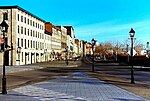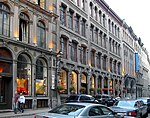Old Port of Montreal
1830 establishments in Lower CanadaAdaptive reuse of industrial structures in MontrealBike paths in QuebecEconomy of MontrealOld Montreal ... and 5 more
Parks in MontrealPorts and harbours of QuebecRedeveloped ports and waterfronts in CanadaSaint Lawrence RiverTourist attractions in Montreal

The Old Port of Montreal (French: Vieux-Port de Montréal) is the historic port of Montreal, Quebec, Canada. Located adjacent to Old Montreal, it stretches for over 2 km (1.2 mi) along the Saint Lawrence River. It was used as early as 1611, when French fur traders used it as a trading post. In 1976, Montreal's Port activities were moved east to the present Port of Montreal in the borough of Mercier–Hochelaga-Maisonneuve.The Old Port was redeveloped in the early 1990s, under the direction of architects Aurèle Cardinal and Peter Rose. It is today a recreational and historical area and draws six million tourists annually.
Excerpt from the Wikipedia article Old Port of Montreal (License: CC BY-SA 3.0, Authors, Images).Old Port of Montreal
Promenade du vieux port, Montreal Ville-Marie
Geographical coordinates (GPS) Address Nearby Places Show on map
Geographical coordinates (GPS)
| Latitude | Longitude |
|---|---|
| N 45.504886 ° | E -73.552386 ° |
Address
Promenade du vieux port 3
H2Y 2E1 Montreal, Ville-Marie
Quebec, Canada
Open on Google Maps











